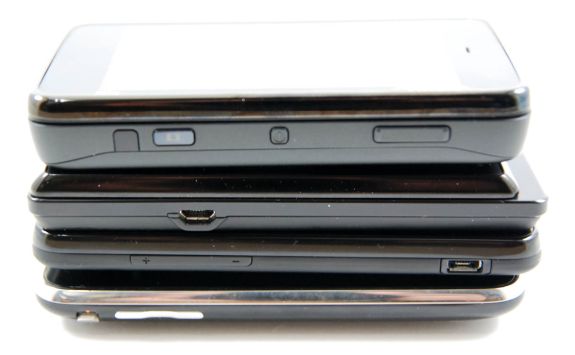Two OMAP 3430 Phones: Nokia N900 and Motorola Droid
by Brian Klug on June 10, 2010 9:29 PM EST- Posted in
- Smartphones
- N900
- Maemo
- Motorola Droid
- Droid
- MeeGo
- Android
- Mobile
Motorola Droid - Impressively Thin
For Motorola, the Droid was a “Hail Mary” launch of a phone. Before launch, many had written off the handset maker as an abject failure. It was important for Motorola to go big - with the largest carrier, the latest Android software, and the most impressive spec sheet - or go home and wait for the company to be sold off in pieces. Given that this nightmare scenario never played out for Motorola, it’s fair to call the hardware a definite success.
At first glance, the Droid is strikingly utilitarian - it’s an unabashedly square, no nonsense, masculine style. At front is the glass-topped 3.7” 854x480, 265ppi screen, (which we’ll talk more about later), and around it is a narrow, seamless bezel. At its bottom are the four capacitive android buttons common to Android phones. There’s a small detent at the bottom where the slider meets the base packing the keyboard. Quite possibly, this is possibly Motorola’s subtle riff on the G1’s much maligned “chin.” Just a few millimeters off center on that chin lies the microphone. What’s interesting is that at right is the Verizon name and swoosh, instead of somewhere around the screen where it would’ve shaven precious space away from the screen. This is definitely a nod in the right direction, guys, it’s phone first - carrier second.
The Droid is thin - impressively thin for packing a hardware keyboard. But what’s most impressive is that it manages to stay thin and contemporary without feeling cheap and flimsy. In fact, most of the phone is metal, and you can feel it in the Motorola Droid’s heft - you won’t forget it’s in your pocket. Just tapping on the exterior, there’s very little if any flexing anywhere. The slider refuses to rotate or wobble when the keyboard is exposed, and there isn’t flexing or plastic squeaking as you get it open. The travel mechanism has a notable start and stop detent, keeping the phone open or shut with a reassuringly snug - but not impossibly stiff - snap. There’s no spring assist to the slider, so you have to push to open and close the keyboard, but that’s hardly a negative. What’s also superb is that there’s no clearance between the keyboard and screen assembly when closed, I couldn’t even get a fingernail inside.












68 Comments
View All Comments
Zebo - Friday, June 11, 2010 - link
with 750mhz processor convex keys and ditching the lame D pad making this the best smart phone for my use talking 5-6 hours a day plus on best network instead of T or TM.krazyfrog - Friday, June 11, 2010 - link
Dude, you chat like an eight year-old lol.CityBlue - Friday, June 11, 2010 - link
The latest Maemo5 PR1.2 does bring a welcome improvement to battery life, in some cases as much as 50% improvement to standby time.The recently released Opera Mobile on the N900 is lightning fast - it would be interesting to see how that performs in your comparison tests, or the latest Fennec (Firefox Mobile 1.1). The stock MicroB browser is beginning to look a little long in the tooth what with all the Javascript run-time improvements in competing browsers, but it does still offer the most complete web experience on pretty much any mobile device.
Overall though, a very good and welcome review of Maemo5 which is much misunderstood by a world obsessed with Android and iPhone.
achipa - Friday, June 11, 2010 - link
Two small corrections:Nokia's next MeeGo device is still going to be ARM (MeeGo is a two-platform OS, ARM and Atom), if there is a Moorestown device far along in the pipelines, it's not Nokia's.
PR1.2 is very likely not the last update. Nokia has pledged to deliver QtMobility (the mobile device Qt APIs) in a future update, and there is an active Qt4.7 branch for Maemo5 which also suggests work is being done there.
The Solutor - Friday, June 11, 2010 - link
Not all the Droid/Milestone's keyboard are flat.http://img96.imageshack.us/img96/5872/dsc00180.png
http://img412.imageshack.us/img412/6551/dsc00176.p...
This is my milestone (bought in december).
So there's no need to wait droid 2 to get the raised keys.
Brian Klug - Friday, June 11, 2010 - link
Interesting... looks like they definitely identified that issue somewhere between finishing the CDMA 'Droid' design and the GSM Milestone. Cool stuff!-Brian
strikeback03 - Friday, June 11, 2010 - link
I read that elsewhere as well. Would be nice if the verizon stores got the newer keyboard models out on display to tryBoyBawang - Sunday, June 13, 2010 - link
Sorry to break your heart dude but the ones with raised keyboard were the early builds. Motorola changed it to flat after reported sliding problems with the raised designstrikeback03 - Monday, June 14, 2010 - link
Actually one of my friends got a Moto Droid Thursday and I had a chance to play with it Friday, it did feel like they had improved the key feel slightly. IIRC the Droids on display had concave keys, this one was slightly convex.solipsism - Friday, June 11, 2010 - link
I understand that's because they are in the same package is the reason why you need the BT to be on to get FM, but that can't be too common. After all, most smartphones seem to have WiFi and BT(+EDR) and FM all the same transceiver.For comparison, the iPhone 3GS uses a <a href="http://www.broadcom.com/products/Wireless-LAN/802.... BCM4325</ a>